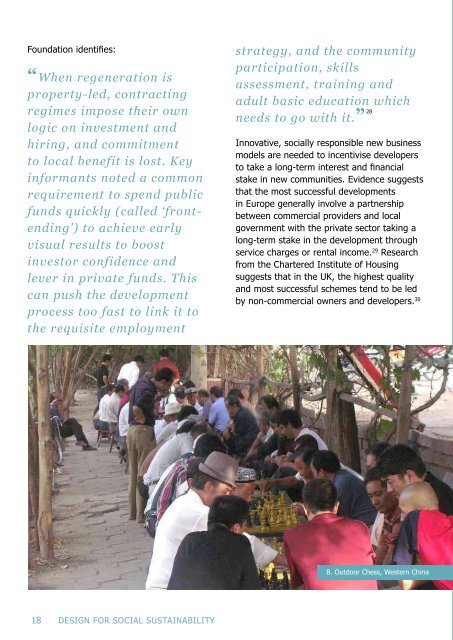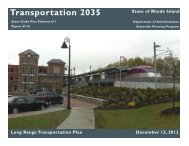Design for Social Sustainability â Saffron Woodcraft, 2010
Design for Social Sustainability â Saffron Woodcraft, 2010
Design for Social Sustainability â Saffron Woodcraft, 2010
Create successful ePaper yourself
Turn your PDF publications into a flip-book with our unique Google optimized e-Paper software.
Foundation identifies:<br />
“When regeneration is<br />
property-led, contracting<br />
regimes impose their own<br />
logic on investment and<br />
hiring, and commitment<br />
to local benefit is lost. Key<br />
in<strong>for</strong>mants noted a common<br />
requirement to spend public<br />
funds quickly (called ‘frontending’)<br />
to achieve early<br />
visual results to boost<br />
investor confidence and<br />
lever in private funds. This<br />
can push the development<br />
process too fast to link it to<br />
the requisite employment<br />
strategy, and the community<br />
participation, skills<br />
assessment, training and<br />
adult basic education which<br />
needs to go with it.” 28<br />
Innovative, socially responsible new business<br />
models are needed to incentivise developers<br />
to take a long-term interest and financial<br />
stake in new communities. Evidence suggests<br />
that the most successful developments<br />
in Europe generally involve a partnership<br />
between commercial providers and local<br />
government with the private sector taking a<br />
long-term stake in the development through<br />
service charges or rental income. 29 Research<br />
from the Chartered Institute of Housing<br />
suggests that in the UK, the highest quality<br />
and most successful schemes tend to be led<br />
by non-commercial owners and developers. 30<br />
“…One of the key determinants of high quality European<br />
residential developments was the leading role played by<br />
the local authority in setting the project on the right course<br />
and in making sure quality was maintained to the end...<br />
getting all the public stakeholders to work together seemed<br />
much easier…often the project had been started by one<br />
or more visionary leaders, but even more important, the<br />
local authority had some financial capacity and the skills<br />
to manage and direct the project itself. The private sector<br />
was invariably involved but within a framework that was<br />
strongly controlled and directed towards the vision that had<br />
been set...many of the builders and investors were relatively<br />
local.”<br />
Beyond Eco-towns, applying the lessons from Europe, URBED, PRP Architects & <strong>Design</strong> <strong>for</strong> Homes (2008)<br />
8. Outdoor Chess, Western China<br />
18 DESIGN FOR SOCIAL SUSTAINABILITY DESIGN FOR SOCIAL SUSTAINABILITY 19
















